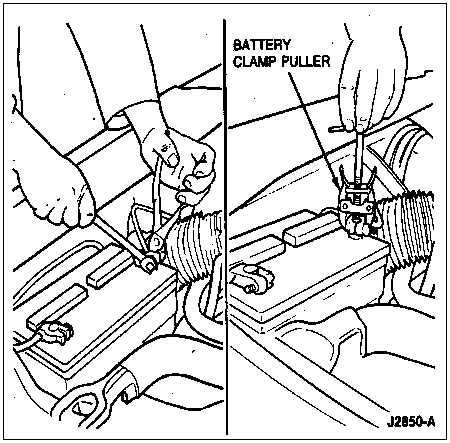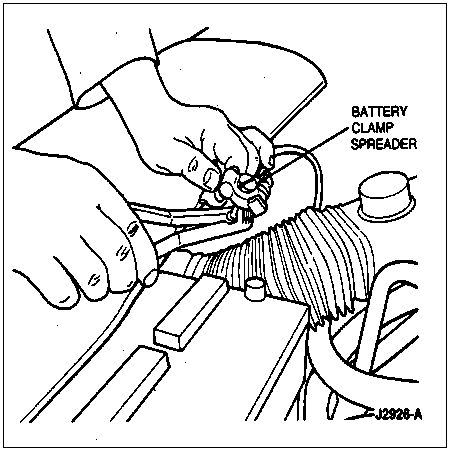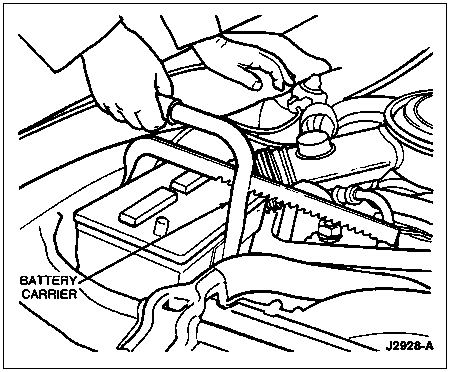
Section 14-01: Battery | 1996 F-150, F-250, F-350, F-Super Duty and Bronco Workshop Manual |
Using properly designed tools can prevent damage to the battery, battery cables and hold-down bracketry. They can also reduce potential hazards to both technician and vehicle being serviced.
Tools and equipment manufactured for servicing batteries have parts insulated to help prevent arcing. This feature can reduce potential component damage and fire hazards if a tool is dropped and shorts the battery terminals.
Pliers
Battery pliers have jaws specifically designed for gripping cable clamp bolts securely. Care should be taken when removing or replacing the cable clamp bolts so that the battery terminal is not subjected to any excessive lateral or twisting forces. Such forces could cause major damage to the internal components of the battery (10655), and leakage at the terminals.
Clamp Puller
Use a clamp puller to remove a cable clamp from the battery terminal. With the jaws gripping the underside of the cable clamp, pull the clamp up by means of pressure exerted against the top of the battery terminal. Proper use of this tool avoids the damaging lateral or twisting forces that result when using a pry bar or pliers.

Clamp Spreader
The spreader is used to expand the cable clamp after it has been removed from the terminal and the clamp bolt has been loosened. The cable clamp can then be easily placed in its correct position completely on the terminal.

Terminal Cleaning Brush
The terminal cleaning brush is designed with units to clean both the tapered battery terminal and the mating surface of the cable clamp. Refer to illustration under Battery in the Removal and Installation portion of this section.
Carrier
![]() WARNING: WHEN LIFTING A PLASTIC-CASED BATTERY, AVOID PUTTING EXCESSIVE PRESSURE ON THE END WALLS, WHICH COULD CAUSE ACID TO SPEW THROUGH THE VENT CAPS CAUSING PERSONAL INJURY, OR DAMAGE TO THE VEHICLE OR BATTERY. LIFT WITH BATTERY CARRIER OR WITH YOUR HANDS ON OPPOSITE CORNERS.
WARNING: WHEN LIFTING A PLASTIC-CASED BATTERY, AVOID PUTTING EXCESSIVE PRESSURE ON THE END WALLS, WHICH COULD CAUSE ACID TO SPEW THROUGH THE VENT CAPS CAUSING PERSONAL INJURY, OR DAMAGE TO THE VEHICLE OR BATTERY. LIFT WITH BATTERY CARRIER OR WITH YOUR HANDS ON OPPOSITE CORNERS.
Use a suitable battery carrier for lifting and transporting the battery. The illustration shows a clamp-type carrier used to grip the side walls of the container just below the lip of the cover. The carrier is used on the side walls, rather than the end walls, since the side walls have additional strength from the inner cell partitions. This is particularly important with the plastic-cased battery which has end walls that are flexible.
